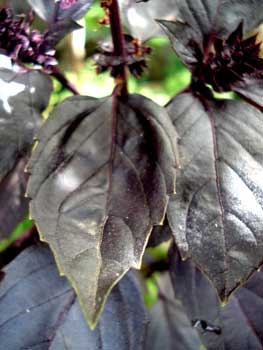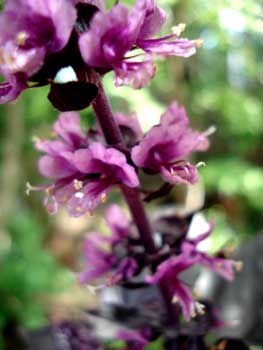
'Red Rubin'
Italian Large-leaf Opal Basil
"Wonderful tales had our fathers of old--
Wonderful tales of the herbs & the stars--
The Sun was Lord of the Marigold,
Basil & Rocket belonged to Mars."
-Rudyard Kipling
(1865-1936)
Developed at the University of Connecticut in the 1950s, Ocimum basilicum var purpurescens, under the cultivar name 'Purpurescens,' quickly became the standard culinary purple, red, or opal basil.(1865-1936)
'Red Rubin' appears really just to be 'Purpurescens,' for which 'Red Rubin' has merely become a preferred common name among marketers, though possibly it really is a "select strain" with darker color.
 Allegedly a cultivar called 'Dark Opal' was an improvement of 'Purpurescens' & 'Red Rubin' an improvement of 'Dark Opal.' But knowledgeable souls not writing sales pitches have insisted 'Dark Opal' & 'Red Rubin' are merely synonyms for 'Purpurascens,' & I seriously think that's true. By the name 'Dark Opal' it was the 1962 All-American Selections Winner.
Allegedly a cultivar called 'Dark Opal' was an improvement of 'Purpurescens' & 'Red Rubin' an improvement of 'Dark Opal.' But knowledgeable souls not writing sales pitches have insisted 'Dark Opal' & 'Red Rubin' are merely synonyms for 'Purpurascens,' & I seriously think that's true. By the name 'Dark Opal' it was the 1962 All-American Selections Winner.'Red Rubin' is a particulary dark mahogany-purple, these leaves holding this color throughout their life cycle. Big bright magenta flowers are of considerable beauty in & of themselves -- & as edible as the leaves -- though it is recommended to pinch off the buds in order to maximize leaf production for kitchen use.
In flavor it is not greatly different from green sweet basil, sharing its soft strength on the palate, very spicy with no bitter qualities.
As with all basils, it needs a sunny spot whether in garden or pot, in organically rich soil which is never allowed to entirely dry out. 'Red Rubin' is a fast grower (even if a little less so than green sweet basil). Even so, as a few leaves will be harvested as often as daily, it sure doesn't hurt to fertilize it every two weeks, to hasten leaf development to even greater heights.
As an annual sensitive to frost, it must be planted outside when there is absolutely no risk of a late frost. If there's any question at all, wait until mid-spring. It will produce leaves right through summer & deep into autumn, but eventually dies away in winter, & will not perennialize.
It's too bad letting it bloom slows down leaf production, as it forces such a difficult choice. I let it bloom a bit for the sake of a couple pictures, but because we use so much basil in the kitchen, after I had an acceptable photo I then picked off all the flowers & buds, which ended up in morning omlets, having quite a different flavor from the leaves.
Continue to:
'Purple Ruffles' Basil